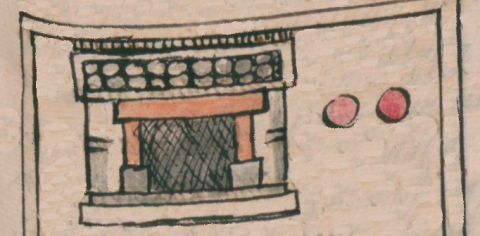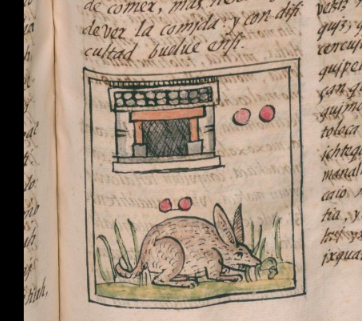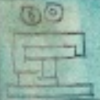Ome Calli (FCbk4f11r)
This colorful painting of a simplex glyph-plus-notation has as its focus the date Ome Calli ("Two House," or 2-House), in the religious divinatory calendar called the tonalpohualli. The glyph is a frontal view of a calli with the wooden beams framing an open entryway (shown as dark gray with hatching). The base of the two upright beams sit on what may be gray stone blocks. The foundation has two layers, a thin gray one and a thicker white one below that. The sides of the building or house (calli) have two short, horizontal, hatch marks about half way up. Above the horizontal wooden lintel is a black rectangle with two horizontal rows of white or gray circles (perhaps representing stars). Very short vertical lines run along the top of the roof. To the right of this building are two small circles painted red. This is the notation for two (ome). This date is boxed in, which is typical of dates, even if there is a shared purpose here of separating the date from the alphabetic text on the page (as the contextualizing image shows).
Stephanie Wood
The frontal view of this calli is different from the profile view in the comparison below, which comes from the Codex Mendoza (c. 1541). The frontal views increase with European influence.
Stephanie
1577
Jeff Haskett-Wood
tonalpohualli, días, fechas, calendarios, casas, edificios, star, stars, estrella, estrellas, calendario, calendar

ome, two, https://nahuatl.wired-humanities.org/content/ome
cal(li), house or building, https://nahuatl.wired-humanities.org/content/calli
Dos Casa, o 2-Casa
Stephanie Wood
Library of Congress, https://www.loc.gov/resource/gdcwdl.wdl_10615?/sp=23&st=image
The Library of Congress is unaware of any copyright or other restrictions in the World Digital Library Collection. Absent any such restrictions, these materials are free to use and reuse. Researchers are encouraged to review the source information attached to each item. If you do publish anything from this database, please cite the Visual Lexicon of Aztec Hieroglyphs.


